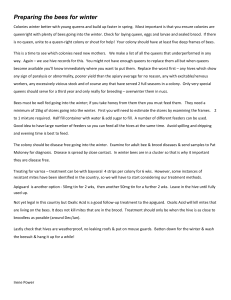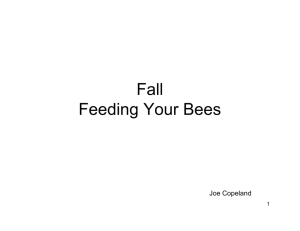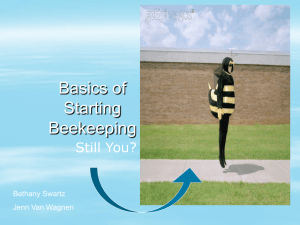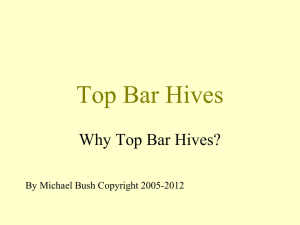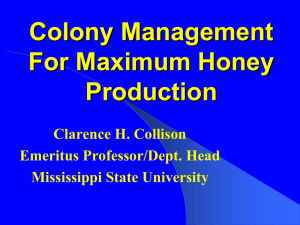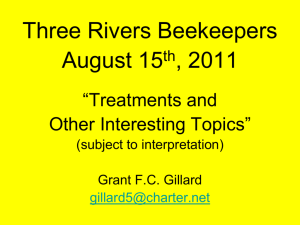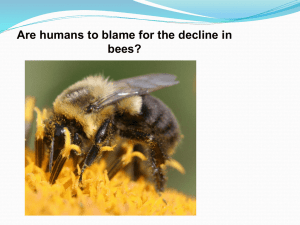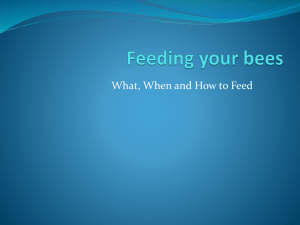Over Wintering Your Bees
advertisement
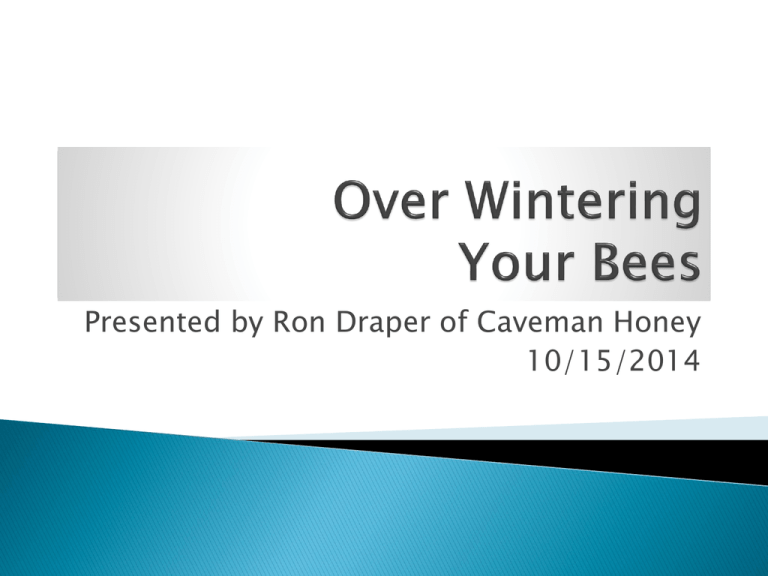
Presented by Ron Draper of Caveman Honey 10/15/2014 Having strong colonies. Having a strong queen for each colony. Feeding your bees before and during winter. Equipment. Wrapping. Wind Blockage. Need to have large colony. A large colony will have approximately 50-60k bees. ◦ Small colonies of 40k or below will usually die of starvation. ◦ Just not enough bees to reach the food on the outside of the frames. ◦ The bees on the outside of the cluster will gather the food from the edges of the frame (just outside of where the brood is on the frame) and past it inwards to the rest. You need to start testing and treating for Varroa mites early. ◦ Testing should start in June/July, because the highest counts usually occur in August and September. ◦ You can perform a Powered Sugar Shake Technique or Alcohol to test for the mites. ◦ You can use a sticky board underneath the hive to collect mites that have fallen of the bees. ◦ You can use a toothpick to pull out drone lava and look for mites on the larva. If a colony is weaken from mites, they most likely WONT SURVIVE the winter. What are varroa mites? ◦ Varroa mites are tiny insects that infest the colony, feeding on the bees. ◦ The varroa mites first appeared in the US in 1987 and have wrecked many of colonies. Bees start to cluster when the outside temperature drops below 50 to 60 degrees. ◦ Clusters usually move up in the hive to retrieve resources. ◦ A strong colony can also move down in the hive to retrieve resources. When doing your last fall inspection, NEVER pull frames out of a hive if the temperature is below 60 degrees. You can damage the brood. Ensure in your last inspection that you see the queen and she looks healthy. Make sure you have at least 4-6 frames of brood. These are the bees you are going to have in the spring. Never really let your queen overwinter 3 years. If you are re-queening, then do so by late August. ◦ This will give you time if you need to re-queen again. ◦ Gives the virgin queen time to mate. Bees need both carbohydrates (honey/sugar water) and protein (pollen) to be healthy. A strong colony eats ½ pound of pollen a day. They have same food requirements as a medium sized dog. In the fall feed a mixture of 2 parts of sugar to 1 part water. ◦ This can be by weight or volume. ◦ Bring your water to a boil and then add your sugar. Don’t bring it back it to boil, because this can caramelize the sugar. Caramelized sugar is unhealthy for the bees. Don’t use entrance feeders during this period, it promotes robbing. When the tempeture drops to low to feed sugar water, then you will need to switch to other methods. ◦ Hard candy boards. ◦ Sugar drop directly on top of the hive on top of newspaper. Remember to feed your pollen patties for protein. Early spring start feeding 1 part sugar to 1 part water, and don’t forget the pollen patties. Equipment ◦ Mouse guards. Add them as soon as the cold weather starts. Mice are one the most destructive things to a hive. You can use your entrance reducer as a mouse guard or you can purchase other devices. Equipment ◦ Hard Candy Board. You can make your own hard candy feed board or purchase them. You need to check them periodically to ensure they still have candy. You may need to add more hard candy to the board several times during the winter. These are usually used instead of the top board. ◦ To Use a Ventilated Bottom Board or Not? Most bee keepers that do use ventilated bottom boards have successfully overwinter their colonies using them. It does help with the ventilation in the hive. Most bees will freeze because condensation that builds up from the heat the bees generate, will drop back down on the bees and when then temperature drops it then freezes the bees. The top board or hard candy board should have notches cut into them to assist in venting. The bees will work to ensure the tempeture of the brood will stay approximately in the mid 90 degrees. Wrapping your hives. ◦ A study completed in Israel didn’t show any large differences in survival rate of hives that were wrapped versus unwrapped hives. ◦ If you choose to wrap your hives, ensure that you notch out an entrance at the bottom and ventilation holes near the top. Hives can be wrapped with roofing paper, installation foam board, or you can purchase Bee Cozy Winter Wrap. Wind Blockage ◦ It is essential that you place wind barriers around your hive. ◦ This helps prevent the gust of winds from blowing over your hives and sending a very cold breeze inside the entrance. A entrance reducer will help with the latter. ◦ Stack the straw bales around the colonies allowing for enough room to work on the hives and allowing the bees room to fly out for cleansing flights. Feed, Feed, Feed. And not only sugar water, but pollen also. Check and treat for varroa mites during the summer. Put in place a wind block. Put in place a mouse guard. Re-queen if necessary. Tom Pankonen – ISU Bee Club Member. He has been my mentor. David Burns – Certified Master Beekeeper. ◦ www.honeybeesonline.com ◦ 217-427-2678 ◦ I have taken his Beginning Beekeeping class and his “Overwintering Bees” class. I highly recommend his classes.


